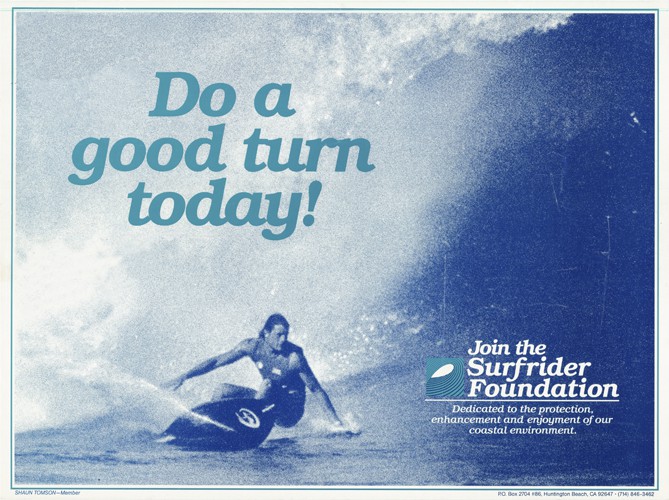
 When I was a young grom, I had a poster on my wall of Shaun Tomson surfing on the North Shore. I looked up to the South African surfer not only because he was a world champion, a successful businessman and a great tube-rider but also because he seemed to be a standup guy.
When I was a young grom, I had a poster on my wall of Shaun Tomson surfing on the North Shore. I looked up to the South African surfer not only because he was a world champion, a successful businessman and a great tube-rider but also because he seemed to be a standup guy.
A man of many talents and interests, Tomson would go on to become an entrepreneur in the surf industry, storyteller, film producer and speaker. As a storyteller and ambassador for the Surfrider Foundation, Shaun says, “The goal is to create this network of positive energy that keeps circulating around the world like a wave.”
Stuart Coleman (SC): When did you first get involved with the Surfrider Foundation?
Shaun Tomson (ST): Surfrider was formed in 1984 by Glenn Hening in Malibu, and he phoned me up. I was on the pro tour at the time. He said, “I’m forming an environmental organization, and we’d love you to be an ambassador.” I said Sure, and I was the first pro surfer to become a member of Surfrider. I’ve been involved with them ever since.
SC: What did you do for Surfrider?
ST: Glenn asked me to lend my voice to Surfrider to help bring in more members and give the organization a voice in the professional surfing community and ultimately in the wider surfer community. He said, “We want to do a poster with you on it.” It was ‘Do a Good Turn,’ and there was a picture of me doing big bottom turn at Pipeline. It was a very cool line with the double-entendre of doing a turn and then doing something good for the ocean. It’s so easy to go out there and just take the waves and not really give anything back.
SC: To be honest, I think a lot of surfers can be self-absorbed and a little selfish.
ST: Surfing has that obsessive quality. It’s such an individualistic sport because you don’t need anyone else to do it. You get this incredible sensation of just you and the ocean. Some surfers do become very self-absorbed and very selfish. It’s like ‘My wave and no one else’s wave!’ The spirit of sharing and aloha is sometimes lost.
SC: Why is that?
ST: Surfing is probably the least expensive lifestyle, art form, whatever you want to call it. You can get a starter board and a pair of shorts, and that’s all you need. It’s very inexpensive to get into and have that incredible enjoyment and exhilaration. But there’s such a tiny portion of the surfing community that belongs to Surfrider…So there are a ton of girls and guys out there who are not members. How do we get those people to join and align with the mission?
SC: Why should people get involved with Surfrider?
ST: Surfrider is there as a protector of the ocean—that’s what it does—it protects the world’s oceans, waves and beaches. If there’s a problem, whether it’s a beach access issue or a water quality issue or pollution issue, Surfrider is there. We’re involved in legal battles all over the country. But some surfers don’t realize that we need the support of the grassroots community, and that [lack of awareness] is something I’ve always found it very hard to understand.
SC: What was one of the biggest campaigns or victories?
ST: I think the Trestles campaign was a big one for everyone at Surfrider. We were able to mobilize everyone to prevent the toll road from going through Trestles and ruining the ambiance of the environment down there.
SC: How has surfing changed?
ST: There are a lot of younger surfers coming in, and they are way more environmentally minded. Surfrider has a great school program. Whenever I talk at schools, I talk about how I got involved with Surfrider. Environmental consciousness has always been part of my makeup. I’ve always believed that when you give, you get a lot more in return. That’s what philanthropy is all about. You feel like your life has more purpose.
SC: With the 30th anniversary of the Surfrider Foundation this Fall, what are your thoughts about where we’ve been and where we’re headed?
ST: I think that people now understand that Surfrider has a pretty big stick. It’s not just an isolated group of surfers. Whether it’s Martin’s Beach or Ma’alaea or Trestles or New York or the Great Lakes, if there’s a problem, Surfrider is there. We have this kind of army, and Surfrider has managed to mobilize these troops. You know, surfers are very individualistic, and Surfrider has been able to corral this energy for the preservation of the ocean.
SC: Along with working with Surfrider, you have written books, produced films and given talks all over the world. What are you working on now?
ST: Right now, I’m 58 years old and I’m doing a Masters in Leadership. It’s a challenge, but I love it! And surfing gave me that inspiration, that juice to keep pushing…You may get punished in life, but you paddle back out to get another ride. That circularity is what surfing teaches you—paddle out, get a wave, paddle back out and get another wave. It’s that knowledge that you’re only going to get the next wave if you paddle back out. It’s a deeply spiritual lesson about life. Surfing gave me that.
